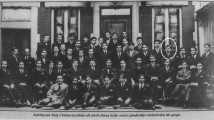Summary
M. W. Beijerinck's activities during his teachership at the Agricultural School at Wageningen are discussed. He hoped to establish a society for breeding and testing new varieties of field crops and to employ ‘seekers’ for better plants in a field crop. Some of hisTriticum herbarium material is still preserved at Delft. His main work was to study the origin of wheat by crossing variousTriticum species. He also investigated the relationship of someHordeum species. If he had remained at Wageningen he might indeed have become the only rediscoverer of Mendel's laws. He would certainly have advanced the research on the origin of wheat.
Similar content being viewed by others
References
Aaronsohn, A., 1906. Auffindung des wilden Emmers in Nord-Palästina. Altneuland, Monatsschrift für die wissenschaftliche Erschliessung Palästinas. Berlin, nos. 7–8: 213–220. Cited byBeijerinck (1911).
Aaronsohn, A., 1910. Rediscovery of wild emmer in Palestina and Syria. Agric. and Bot. Explorations in Palestine: 42. Cited byBeijerinck (1911).
Ascherson, P. &Graebner, R., 1898–1902. Synopsis. 2, p. 676. Cited byBeijerinck, 1911.
Beijerinck, M. W., 1882. Hebben de wetenschappelijke onderzoekingen van de laatste jaren nieuwe gezichtspunten geopend ten aanzien van de verbetering onzer kultuurplanten? Verslag van het Verhandelde op het 35ste Ned. Landhuish. Congres gehouden te Wageningen van 26 tot 29 juni 1882. Wageningen, 61: 162–168.
Beijerinck, M. W., 1884a. Kunnen onze cultuurplanten door kruising verbeterd worden? Verslag van het Landbouwcongres van 22–25 juli 1884 te Amersfoort: 137–150. Verzamelde geschriften vanM. W. Beijerinck, 1921, 1: 359–366.
Beijerinck, M. W., 1884b. Ueber den WeizenbastardTriticum monococcum ♀ ×Triticum dicoccum ♂. Ned. Kruidk. Archief, 2e serie, 4e deel, 2e stuk: 189–201. Verzamelde geschriften vanM. W. Beijerinck, 1921, 1: 401–408, plate III.
Beijerinck, M. W., 1886. Ueber die Bastarde zwischenTriticum monococcum undTriticum dicoccum. Ned. Kruidk. Archief, 2e serie, 4e deel, 4e stuk: 455–473. Verzamelde geschriften van M. W.Beijerinck, 1921, 1: 415–426.
Beijerinck, M. W., 1888. Over kruisingsproeven met kultuurgerst. Verslagen en Mededelingen der Kon. Akad. Wetenschappen, Amsterdam 3e reeks, deel 5: 202. Verzamelde geschriften van M. W.Beijerinck, 1921, 2: 189.
Beijerinck, M. W., 1911. De ontdekking van den stamvorm der kultuurtarwe. De levende Natuur 16: 49–55.
Broekema, L., 1922. Toespraak bij het aanvaarden van het doctoraat in de Landbouwwetenschap, honoris causa. Jaarboek Landbouwhogeschool. 4: 67–71.
Focke, W. O., 1881. Die Pflanzenmischlinge. Berlin, 560 pp.
Godron, D. A., 1870. Histoire d'Aegilops hybrides. Nancy. Cited byBeijerinck, 1884b.
Itallie-van Embden, W. van, 1928. Interview met M. W. Beijerinck. De Groene Amsterdammer 17-3-1928. English translation published in VAN ITERSON et al. (1940), pp. 190–192.
Iterson, G. van,Dooren de Jong, L.E. den &Kluyver, A. J., 1940. Martinus Willem Beijerinck, 's-Gravenhage, 193 pp.
Jahn, I., 1965. W. O. Focke - M. W. Beijerinck und die Geschichte der “ Wiederentdeckung” Mendels. Biol. Rundschau 3: 12–25.
Lamarck, A., 1786. Encyclopédie méthodique 2. Froment: 554–563.
Mac Key, J., 1966. Species relationship inTriticum. Hereditas, Suppl. 2: 237–276.
Nägeli, C. von, 1884. Abstammungslehre. München-Leipzig. Cited byBeijerinck, 1884b.
Smith, L., 1951. Cytology and genetics of barley. Bot. Rev. 17: 1–51, 133–202, 285–355.
Stomps, Th. J., 1954. On the rediscovery of Mendel's work by Hugo de Vries. J. Heredity 45: 293–294.
Veer, P. H. W. A. M. de, 1969. Leven en werk van Hugo de Vries. Groningen 252 pp.
Yagil, E. &Stebbins, G. L., 1969. The morphogenetic effects of the hooded gene in barley. I. Cytological and environmental factors affecting gene expression. Genetics 62: 307–319.
Zeven, A. C., 1969. L. Broekema's segregation ratios of three wheat characters in 1887. Euphytica 18: 286–292.
Author information
Authors and Affiliations
Rights and permissions
About this article
Cite this article
Zeven, A.C. Martinus Willem Beijerinck a hybridizer ofTriticum andHordeum species at the end of the 19th century and his investigations into the origin of wheat. Euphytica 19, 263–275 (1970). https://doi.org/10.1007/BF01902955
Received:
Issue Date:
DOI: https://doi.org/10.1007/BF01902955




